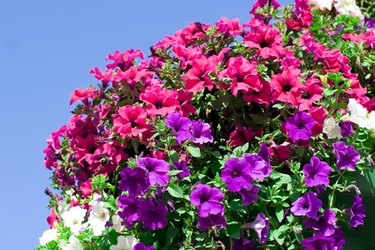
Petunias, known for their clear, rich colors, are a bright and sometimes fragrant addition to any flower garden. Easy to grow and care for, petunias bloom all summer long. Petunias are annuals. Hundreds of varieties exist in nearly every color, size and flower form. Purple petunia and white petunia varieties are often sweetly aromatic.
Colors
Video of the Day

Petunias come in a dizzying array of colors, from dazzling white to an almost black purple. Blue flowers are rare in the plant world, but petunias have several shades from which to choose, along with dark crimson, salmon, yellow and pink. Many petunia varieties feature flowers with one main color, such as white, with darker colored eyes. Ultra Crimson Star is purple and white striped, while Merlin Blue Morn is deep blue with white centers. Wave Purple is almost burgundy with dark eyes. Red Pirouette is a red and white double picotee.
Video of the Day
Flower Types
Five basic types of petunias are readily available to the home gardener. Grandiflora petunias have large flowers and may have an upright or trailing habit. The blossoms are single or double and may sport fringed petals. The flowers, which are less abundant on grandifloras than other types of petunias, are as large as 5 inches across. Multiflora petunias produce smaller flowers than grandiflora, but what they lack in size they make up for in quantity and quality. Multifloras produce single and double blooms, depending upon variety. Floribundas fall somewhere between grandiflora and multiflora, with abundant, medium-sized blooms. If you like miniatures, consider milliflora petunias. These small plants with 1- to 1 ½-inch profuse blooms have a neat, compact habit and are unlikely to grow leggy or spindly late in the flowering season. Spreading petunias, as the name implies, sprawl outward as much as 2 to 4 feet from the base of the plant. A group of petunias trademarked as the Wave series was introduced in 1995 and includes Shock Wave, Easy Wave, Tidal Wave and Double Wave. A series is a group of closely related plants that usually have identical characteristics and generally differ only in flower color. Tidal Wave grows up to 22 inches tall, but other Wave petunias only grow about 6 inches tall.
Uses
Petunias are versatile enough for dozens of uses. Plant them in containers, hanging baskets or window boxes. Use milliflora petunias as border or bedding plants and larger varieties as background plants for smaller flowering plants. You can mass the plants for a large display of color or mix them here and there among foliage plants or spring-blooming plants to extend the flowering period in your garden.
Growing Tips
Plant petunias after all threat of frost has passed in spring. Petunias can be started indoors from seed, but the process is more difficult than purchasing seedlings from a nursery. Petunia seedlings need to be "hardened off" before you plant them in the garden. Place the seedlings in their nursery containers outside in a shady spot and gradually, over the course of a few days, move them into direct sunlight. Plant the seedlings in full sun to light shade in well-drained, fertile soil. Amend the soil, if needed, with organic matter before planting. Plant spreading petunias 1 to 2 feet apart; space other types of petunias about a foot apart. Pinch the tips of grandiflora and multiflora seedlings to encourage branching.